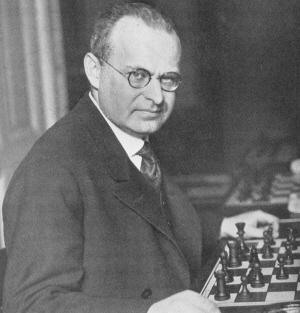
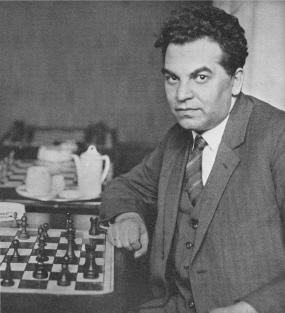
Chess
Notes
|
| First column | << previous | Archives [54] | next >> | Current column |
Elmer Sangalang (Manila, the Philippines) writes:
‘In a simultaneous exhibition in 1947 the ten-year-old Boris Spassky won against the future world champion Mikhail Botvinnik. Is the game-score extant? In 1990 Spassky wrote to me that he did not have it.’
For a photograph of the occasion, see the front cover of the 7/1988 New in Chess.
Two fine photographs of Nimzowitsch and Réti which we have occasionally reproduced from pages 159 and 82 of Alt om Skak by B. Nielsen (Odense, 1943) prompt a question from Maurice Carter (Fairborn, OH, USA): bearing in mind that the chess sets and boards appear to be identical, on what occasion were the photographs taken?


Page 17 of our book on Capablanca gave a chart of the time consumed by the players in their 23-game match in 1909:
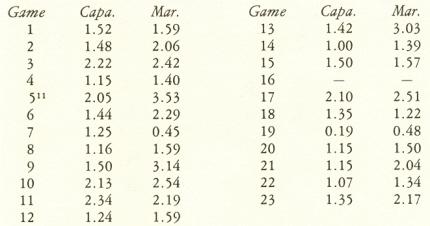
Our source was the June, July and August 1909 issues of the American Chess Bulletin, which omitted the timings only for game 16 (a draw at the Brooklyn Chess Club on 21 May). Information for that game was also absent from the table on page 6 of Imre König’s book on the match (San Francisco, 1955). The match book published in Stockholm in 1916 gave no clock times.
Is there any hope of finding the missing details for game 16?
Fabrizio Zavatarelli (Milan, Italy) notes on page 456 of Carlo Salvioli’s Il Giuoco degli Scacchi (third edition, Livorno, 1921) a ‘Blackburne-Mackenzie’ game which he has not seen elsewhere:
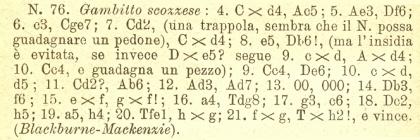
1 e4 e5 2 Nf3 Nc6 3 d4 exd4 4 Nxd4 Bc5 5 Be3 Qf6 6 c3 Nge7 7 Nd2 Nxd4 8 e5 Qb6 9 Nc4 Qe6 10 cxd4 d5 11 Nd2 Bb6 12 Bd3 Bd7 13 O-O O-O-O 14 Qb3 f6 15 exf6 gxf6 16 a4 Rdg8 17 g3 c6 18 Qc2 h5 19 a5
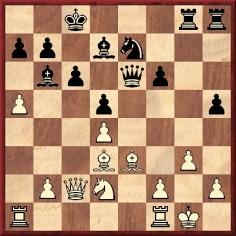
19...h4 20 Rfe1 hxg3 21 fxg3 Rxh2 and wins.
What is known about the game? It was still being given, in
unchanged format, in much later editions of Salvioli’s book.
See, for instance, page 546 of the eighth edition (Florence,
1961).
From Jonathan Manley (Oxford, England):
‘I recently received this image from Pamela Fontana, a descendant of Potter, who is writing a biography of his only sister, the Venerable Mary Potter. She was the founder of the Little Company of Mary, an international Order whose main work is in caring for the terminally sick, and the photograph comes from the Company’s archives.’
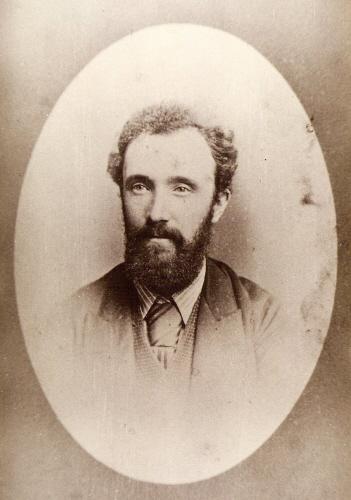
William Norwood Potter
Mark N. Taylor (Mt Berry, GA, USA) draws attention to a passage in the chapter about Fred Reinfeld on pages 61-67 of The Fascination of Book Publishing by David A. Boehm (New York, 1994):
‘Fred had what he thought was a headache, which turned into an earache. On Saturday [sic] night, he fell asleep. He never woke up.
Death had been caused by an aneurysm.
Webster: “Aneurysm. A permanent abnormal blood-filled dilating of an artery, resulting from a disease of a vessel wall.”
Fred had been born with it and at 54 years of age, it had burst and flooded his brain.’
The reliability of the information is an open question, since the chapter has such dubious statements as the following on page 61:
‘Before Fred Reinfeld was six, he had mastered the chessboard ...’
Our Factfinder has an entry ‘Reinfeld, Fred (when he learned chess)’. In none of his contradictory claims did he profess familiarity with the game at such an early age.
Zdeněk Závodný (Brno, Czech Republic) notes that the same photograph of Réti, although showing more of the board position, was published in the 11 June 1929 issue of the Czech magazine Letem světem.
Page 27 of The Even More Complete Chess Addict by M. Fox and R. James (London, 1993) stated that John Reginald Halliday Christie (who lived at 10 Rillington Place) ‘was a goodish chessplayer’ and that ‘Whilst awaiting the ultimate punishment in Brixton, he passed the time thrashing his warders at chess (Chris the chess champion, they nicknamed him).’ The grounds for these assertions remain to be discovered, since much of the book is a source-free zone.
On a documented basis we can add that two other British serial murderers regularly played chess against each other. On page 132 of The Gates of Janus (Los Angeles, 2001) Ian Brady described playing chess against Graham Young in Parkhurst Prison on the Isle of Wight:
‘An inveterate but excitable chessplayer, he rather foolishly favoured the black pieces, likening their potency to the Nazi SS. His daily opponent on the board for years was the author of this book, against whom Young always failed to win a match.’
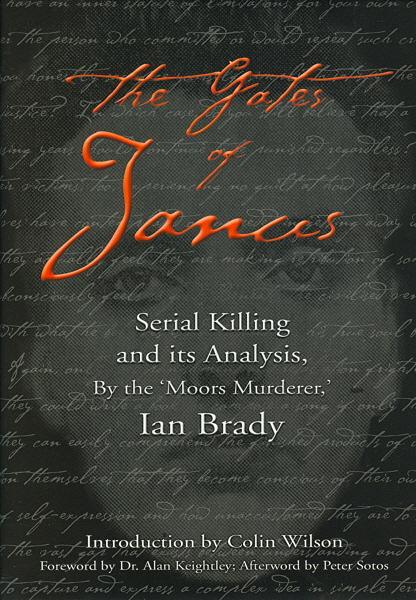
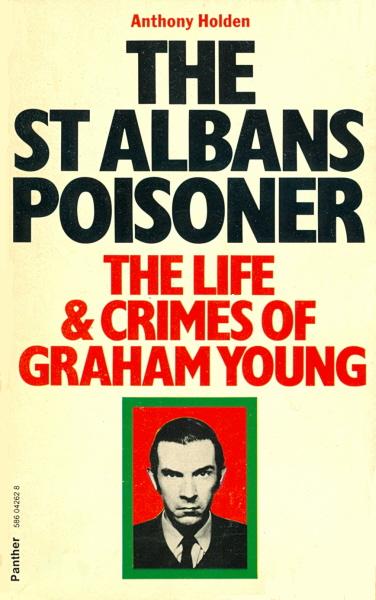
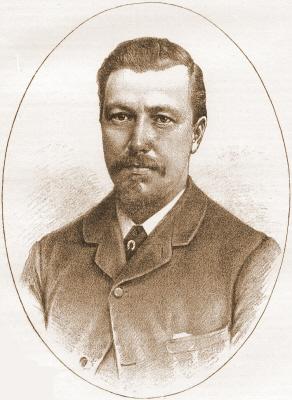
Joseph Henry Blackburne
A number of webpages and other outlets specializing in (i.e. making do with) unattested ‘chess quotes’ loosely attribute to J.H. Blackburne the remark ‘chess is a kind of mental alcohol’. A contemporary source is long overdue, so we mention that the observation is to be found in an interview with Blackburne which originally appeared in the Daily Chronicle and was reproduced on pages 87-88 of the 1 May 1895 issue of the Chess Player’s Chronicle:
‘Chess is a kind of mental alcohol. It inebriates the man who plays it constantly.’
Below is the full item from the magazine:
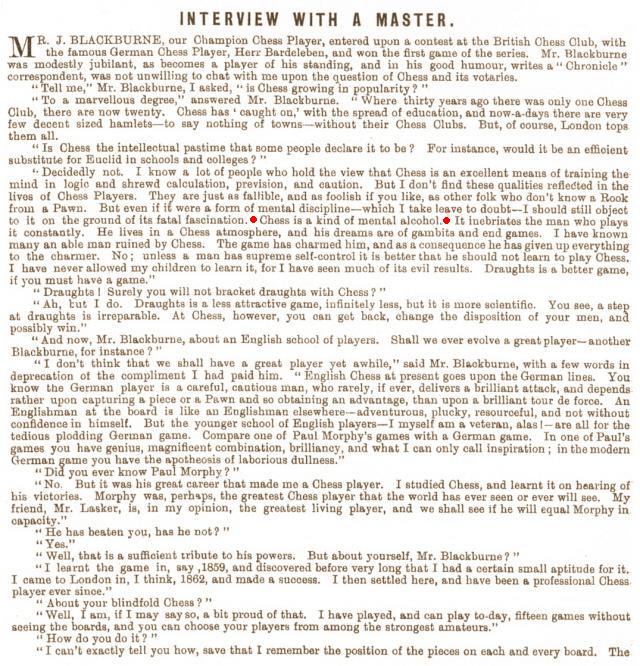

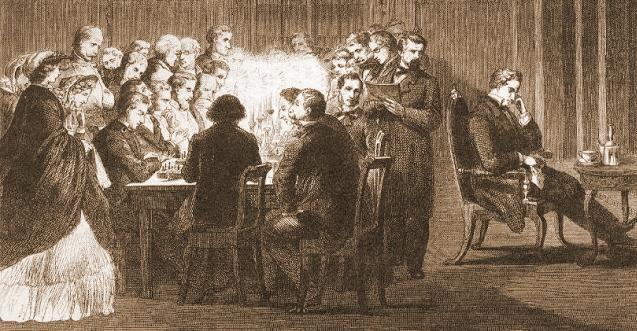
Louis Paulsen
‘The whole subject is chaotic’ was our comment in C.N. 898 regarding attempts to establish a list of the progressive records for the number of blindfold games played simultaneously. Nearly a quarter of a century on, the chaos has been removed, thanks to Blindfold Chess by Eliot Hearst and John Knott (Jefferson, 2009). Appendix A (pages 395-406) is entitled ‘“World Record” Blindfold Simultaneous Exhibitions Since 1782’, and we summarize here the sequence of record-breaking displays in terms of number of boards:
1782, London: F.A.D. Philidor (2)
1783, London: F.A.D. Philidor (3)
1851, Paris: L. Kieseritzky (4)
1857, New York: L. Paulsen (5)
1858, Dubuque: L. Paulsen (7)
1858, Dubuque: L. Paulsen (8)
1858, Chicago: L. Paulsen (10)
1858, St Louis: L. Paulsen (12)
1859, Dubuque: L. Paulsen (15)
1876, London: J.H. Zukertort (16)
1900, New Orleans: H.N. Pillsbury (17)
1900, Philadelphia: H.N. Pillsbury (20)
1902, Hanover: H.N. Pillsbury (21)
1902, Moscow: H.N. Pillsbury (22)
1904, Moscow: V. Ostrogsky (23)
1919, Haarlem: R. Réti (24)
1921, Kaschau: G. Breyer (25)
1924, New York: A. Alekhine (26)
1925, Paris: A. Alekhine (28)
1925, São Paulo: R. Réti (29)
1931, Antwerp: G. Koltanowski (30)
1933, Chicago: A. Alekhine (32)
1937, Edinburgh: G. Koltanowski (34)
1943, Rosario: M. Najdorf (40)
1947, São Paulo: M. Najdorf (45).
Blindfold Chess includes the available particulars in each case, and the first section (pages 207-312) of Part III presents all the game-scores traced from these exhibitions – about 300 games in all.
The above list omits the display by János Flesch (supposedly 52 boards in Budapest in 1960) for the reasons discussed on pages 99-110. The last two pages of that section have a report entitled ‘A Sensational Postscript: Flesch vs Barcza!?’ which relates that four Hungarian contacts independently told the co-authors that a year or two after Flesch’s exhibition Gedeon Barcza described Flesch as a ‘crook’ and a ‘fraud’ and was then sued by Flesch for defamation of character. Whether any such case went to trial has yet to be established. Can it be hoped that a researcher in Hungary will look into the matter?
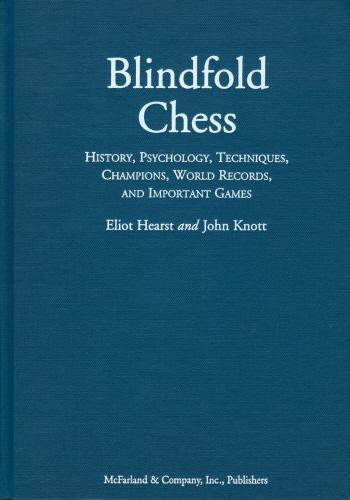
Gordon Cadden (Newport, Wales) asks whether New York, 1857 (see C.N.s 3828 and 4780) is the first occasion when identifiable chess masters (e.g. Morphy and Paulsen) were photographed.
We can think of no earlier case but wonder whether the picture below of Staunton has been authoritatively dated, with firm information on its provenance. It became well known after appearing on page 102 of David Lawson’s 1976 monograph on Morphy.
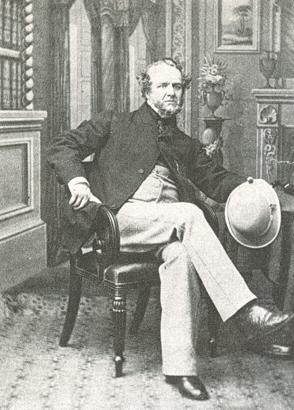
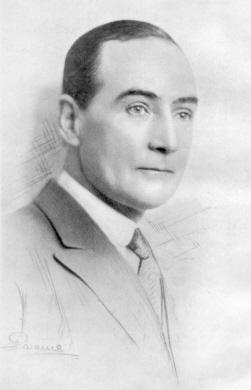
Philip Walsingham Sergeant (frontispiece of his book A Century of British Chess)
C.N. 3190, an item no longer online, listed the non-chess books by P.W. Sergeant in our collection. One title acquired since then has been added below, and we believe that the list is now complete.
The list does not include recent reprints; the most common of these is Witches and Warlocks, of which a paperback edition was published by Senate, London in 1996.
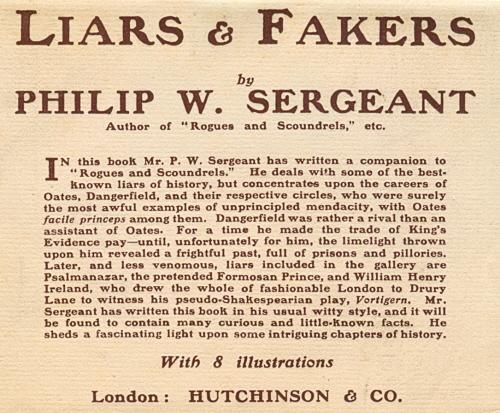
Yasser Seirawan (Amsterdam) asks, following on from C.N. 5932, which future world champions played previous title-holders in simultaneous displays.
Readers’ help in drawing up full details will be welcome. A familiar case is Botvinnik’s defeat of Capablanca in Leningrad in November 1925. As mentioned on page 105 of our book on Capablanca, it has also been claimed that in 1920, when not yet world champion, the Cuban drew with Euwe. See page 95 of volume two of Around The Chess World in 80 Years by N.J. Divinsky (St Leonards on Sea, 1965).
A famous game won by David Bronstein in a simultaneous display in Sochi in 1950: 1 e4 e5 2 d4 exd4 3 Qxd4 Nc6 4 Qa4 Nf6 5 Nc3 d5 6 Bg5 dxe4 7 Nxe4 Qe7 8 O-O-O Qxe4
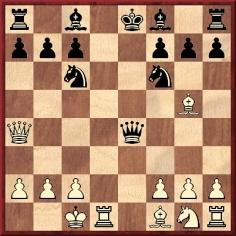
9 Rd8+ Resigns.
Can any more details be found about the occasion and Black’s identity? Moreover, to what extent was the game known before Bronstein published it on page 13 of his book 200 otkritikh partii (Moscow, 1970)?
Eduardo Bauzá Mercére (New York, NY, USA) sends this game from page 112 of The Globe (Buffalo), November 1876:
A.P. Barnes – F.W.1 e4 e5 2 Nf3 Nf6 3 Bc4 Nxe4 4 Nc3 Nxc3 5 dxc3 d6 6 Nxe5 Qe7 7 Bxf7+ Kd8 8 O-O Qxe5 9 Re1 Qf6 ‘and White announced mate in 11 moves’.
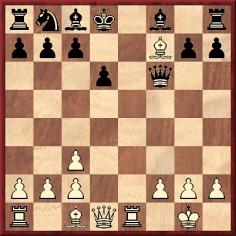
However, this is not an instance of an announced mate which is longer than the game itself (see page 164 of Chess Explorations, pages 8-10 of Kings, Commoners and Knaves and page 50 of A Chess Omnibus), because from the diagrammed position there is a mate in nine.
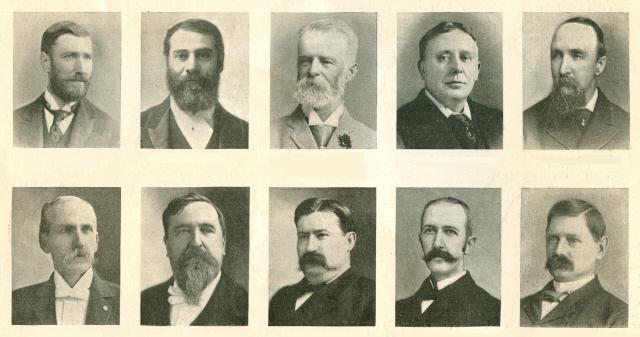
Into which of our feature articles will this set of photographs be incorporated shortly?
Albert Frank (Brussels) asks which crime novel featured A. Troitzky’s famous study (Novoye Vremya, 1895) with mate administered by a single bishop.
It was The Bishop Murder Case by S.S. van Dine (New York and London, 1929). We reproduce pages 264-265 of the edition published by Grosset & Dunlap, New York:
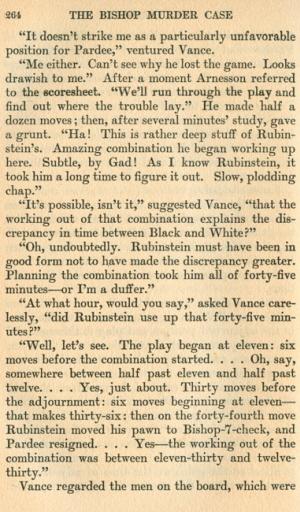
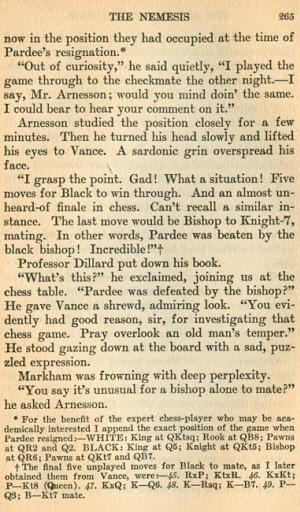
‘Pardee v Rubinstein’ was mentioned on page 24 of Kings, Commoners and Knaves, and below is an item from page 55 of the March 1929 American Chess Bulletin:
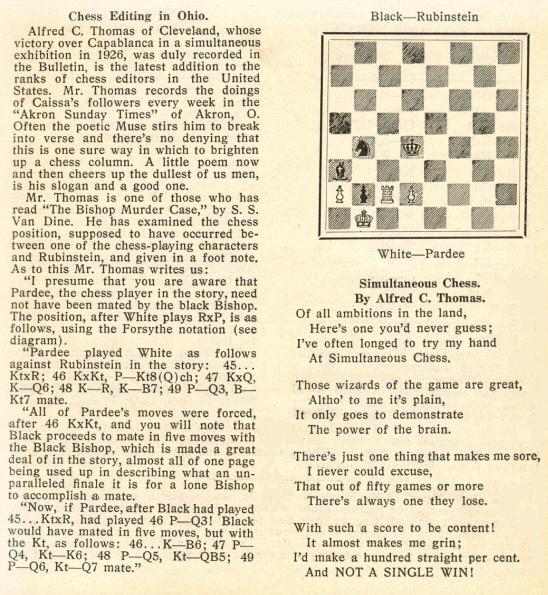
From the above-mentioned edition of van Dine’s book comes this picture:
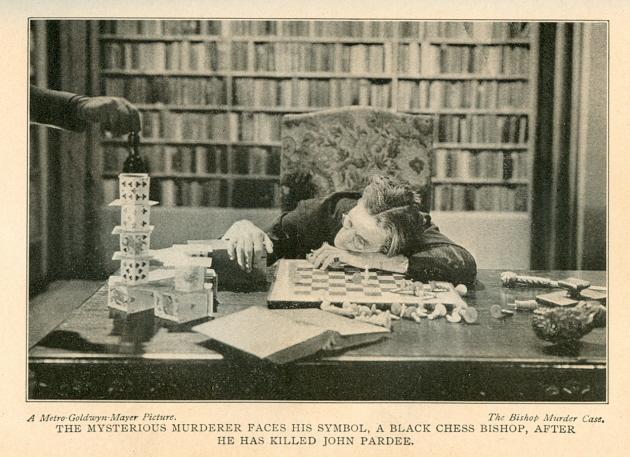
A photograph of Alekhine with the novelist was given in C.N. 5126.
Regarding instances of an announced mate which is longer than the game itself, the following encounters have been discussed in C.N.:
The accuracy of the last two cases has yet to be demonstrated.
In C.N. 5946 we remarked concerning Barnes v F.W., New York, circa 1876:
‘However, this is not an instance of an announced mate which is longer than the game itself (see page 164 of Chess Explorations, pages 8-10 of Kings, Commoners and Knaves and page 50 of A Chess Omnibus), because from the diagrammed position there is a mate in nine.’
In the light of a comment received from Stephan Bird (Caernarfon, Wales) we clarify that in this topic ‘announced mate’ refers to a correct announcement of the shortest possible forced mate.
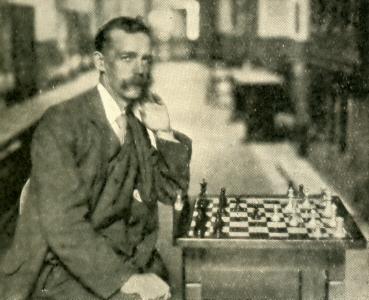
Henry Ernest Atkins (BCM,
October 1924, page 406)
From an article by G.H. Diggle in the October 1976 Newsflash and reproduced on page 16 of Chess Characters (Geneva, 1984):
‘... we well remember his giving a “simultaneous” at the Lincoln Chess Club in 1924, winning 17 and drawing two. One of his more elderly opponents (a notorious non-resigner) who for 30 moves had been wobbling along with a piece down until “time” had to be called, then proceeded to “demonstrate a draw” by concocting a continuation so optimistic that even clubmates with lifelong experience of his powers stood aghast. Atkins, with his greatcoat on ready to go home, made no attempt to refute this analytical masterpiece but merely remarked with great deference: “I don’t think we can play it quite like that!” and then beat a craven retreat “escorted by Club Officials”.
An unobtrusive man, we last saw him as a spectator at “Nottingham, 1936” wandering about as if he was nobody.’
The game ascribed to G.H. Mackenzie in an 1877 publication (C.N. 5931) was attributed to H.A. Kennedy on page 298 of volume five (1844) of the Chess Player’s Chronicle:
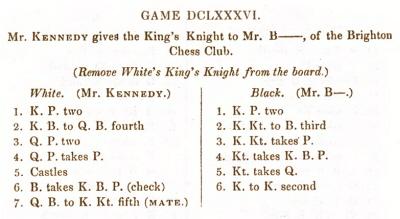
Marc Hébert (Charny, Canada) notes on page 192 of the 14/2007 Quarterly for Chess History a reference to ‘Aleksander (actually – Avrohom) Flamberg’ and asks for further information on the forename.
The writer of the article, Tomasz Lissowski (Warsaw), tells us:
‘Flamberg used the “modern” form of his forename, Aleksander, but the inscription on his grave at the Jewish Cemetery, Okopowa Str., Warsaw states that his first name was Avrohom.’
A photograph has been supplied by Mr Lissowski:
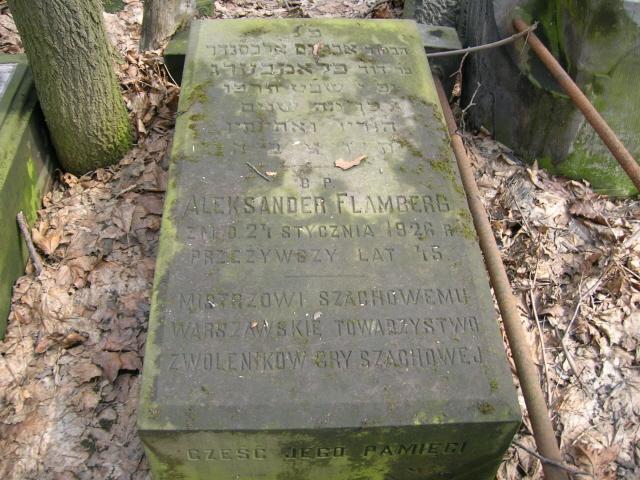
As regards games played by future world champions against previous title-holders in simultaneous displays, our list now stands as follows:
Acknowledgements: Javier Asturiano Molina (Murcia, Spain), Eduardo Bauzá Mercére (New York, NY, USA) and Hassan Roger Sadeghi (Lausanne, Switzerland).
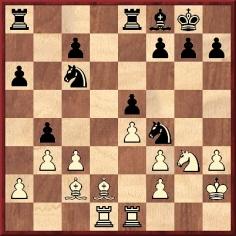
This position occurred after 21 Rfe1 in Tartakower v Réti, New York, 1924. Black played a rook to d8, but which rook?
The question has been put to us by Charles Sullivan (Davis, CA, USA), who comments that although various sources, including databases, give the next move as 21...Rad8, The Book of the New York International Chess Tournament 1924 by A. Alekhine (New York and London, 1925) put ‘KR-Q’ on page 191 and appended this note on the next page:
‘The queen’s rook stays at its own square in order eventually to make a demonstration on the queen’s side (P-QR4).’
We note, though, that page 267 of the German edition of
Alekhine’s tournament book (Berlin and Leipzig, 1925) stated
that the move played was 21...Rad8. Alekhine wrote that moving
the king’s rook to d8 would have been an improvement:
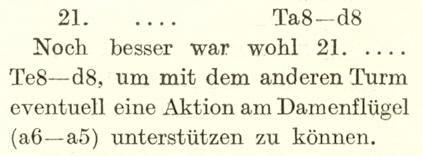
Tartakower annotated the game, which he lost, on pages 220-222 of the August 1924 Wiener Schachzeitung. 21...Rad8 was the move given, with an exclamation mark. It may therefore be strongly suspected that 21...Red8 in the English edition of the New York, 1924 book was wrong, possibly owing to a misunderstanding and/or translation error, but the matter has yet to be put beyond doubt.
Notwithstanding the quality of Alekhine’s annotations, the book was a lax production. C.N. 2131 (see page 283 of Kings, Commoners and Knaves) mentioned that W.H. Watts added a nine-page errata supplement (to the British edition, of which he was the publisher). The list sheds no light on the ‘Which rook?’ puzzle but is, of course, indispensable in connection with any English-language edition of Alekhine’s book.

American Chess Bulletin, July-August 1925, page 123.
Most of the corrections in the nine-page list, referred to in C.N. 5954, concern notation, but below are some examples of substantive matters:
Eduardo Bauzá Mercére (New York, NY, USA) quotes from page 143 of The Globe (Buffalo), January 1877:
‘Mr Bird, the celebrated English chessplayer, has been spending a few days in our city during the past month, and has been contesting with our players, but few of whom have had any degree of success with him. Mr Richmond has been most successful, although Mr Bird has won a large majority of games contested with him.’
A game was given on page 160 of the February 1877 issue:
Henry A. Richmond – Henry Edward Bird1 e4 e5 2 Nf3 Nc6 3 Bc4 Bc5 4 d3 Nf6 5 Be3 d6 6 h3 a6 7 Nc3 h6 8 O-O O-O 9 Bxc5 dxc5 10 a3 Qd6 11 Ne2 Ne7 12 Ng3 Ng6 13 Kh2 Kh7 14 Nf5 Bxf5 15 exf5 Ne7 16 Nh4 b5 17 Bb3 Qd4 18 g4 Qxb2 19 Nf3 Rad8 20 g5 hxg5 21 Nxg5+ Kg8 22 Qf3 Qd4 23 Ne4 Nxe4 24 dxe4 c4
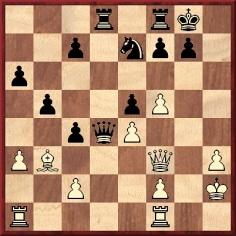
25 Rg1 Qd2 26 Rxg7+ Kh8 27 f6 Qf4+ 28 Qxf4 exf4 29 fxe7 Kxg7 30 exf8(Q)+ Kxf8 31 Ba2 Rd2 32 Rc1 Rxf2+ 33 Kg1 Re2 34 Bb1 Rxe4 35 c3 Re3 36 Bf5 c5 37 Bc8 a5 38 Ba6 b4 39 axb4 axb4 40 cxb4 cxb4 41 Bxc4 Rc3 42 Rxc3 bxc3 Drawn.
C.N. 5647 gave an extract from The Pleasures of Chess by
Assiac (New York, 1952):
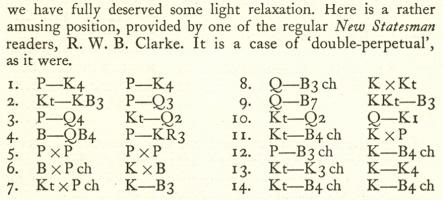
1 e4 e5 2 Nf3 d6 3 d4 Nd7 4 Bc4 h6 5 dxe5 dxe5 6 Bxf7+ Kxf7 7 Nxe5+ Kf6 8 Qf3+ Kxe5 9 Qf7 Ngf6 10 Nd2 Qe8 11 Nc4+ Kxe4 12 f3+
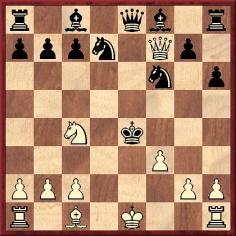
12...Kf5+ 13 Ne3+ Ke5 14 Nc4+ Kf5+ Drawn.
We have still found no other games which finished with, in Assiac’s term, ‘double-perpetual’.
Frederick S. Rhine (Park Ridge, IL, USA) recalls a passage from page 153 of Pollock Memories by F.F. Rowland (Dublin, 1899). The writer is Pollock.
‘But I should like to see a position which Mr Loyd told me he had constructed some years ago – or, at least, was constructing. It was a sort of problem in which both kings were in perpetual check, and neither could escape, nor could either side either win or lose the game. He called it “The Whirlpool”.’
Our correspondent asks whether more is known about Loyd’s construction.
Michael McDowell (Westcliff-on-sea, England) points out to us that the Pollock passage was quoted at the start of an article ‘Consecutive Checks Task’ by John Roycroft on pages 56-57 of the July-September 1976 issue of The Problemist. It seems that no information about a Loyd ‘whirlpool’ composition has been found, but on a similar theme we pick from Mr Roycroft’s rich article a study by E.B. Cook published in the Illustrated London News of 7 June 1856:
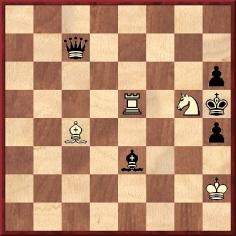
White to move and draw.
Solution: 1 Bf7+ Kg4 2 Be6+ Kf4 3 Rf5+ Kg4+ 4 Re5+ Kf4 5 Rf5+.

From Gene Gnandt (Houston, TX, USA):
‘I believe that the photograph of Howard Staunton in C.N. 5942 (above) was used as a basis for an engraving by, if I read the initials correctly, P.M.E. Taylor.
The engraving appeared in Staunton’s obituary in the Illustrated London News of 4 July 1874. This says nothing about the date of the photograph, but it seems more likely to be from the early 1860s than near his death. Staunton looks younger than he does in the group photograph from Redcar, 1866 in C.N. 5614.
The complication with finding the earliest photograph of a master player is that periodicals and books in the 1850s were not able to reproduce photographs directly. They had to be copied to an engraving. On pages v-vi of his Preface to The Exploits and Triumphs, in Europe, of Paul Morphy, The Chess Champion (New York, 1859) Frederick M. Edge gave sources for the sketches in his book:
“The cuts with which this work is embellished have been engraved by the well-known Brothers Dalziel. The portrait of Paul Morphy, copied from a photograph taken shortly after his arrival in London last year, is an excellent likeness.
The portraits of Messrs Staunton, Boden, Anderssen and Löwenthal are copies of photographs, for which they sat at the Manchester Meeting, in 1857. The originals of Messrs Saint Amant and Harrwitz are admirably executed lithographs of those gentlemen, taken about four years ago, and that of Mr Mongredien is copied from a photograph kindly lent for the purpose.”
The photographs themselves, therefore, may have gone unpublished.
The shot of Staunton given in C.N. 5942 may have been forgotten by the time technology became available to reproduce it, and thus David Lawson was able to surprise us a century later with its existence. The earliest reference to photographs of masters that I was able to find comes with regard to a well-known sketch which appeared on page 44 of the Illustrated London News, 14 July 1855. Over 40 years later, Rosario Aspa wrote a letter to the BCM (August 1896, pages 331-332) about Marmaduke Wyvill. He remarked in part:
“In those days I had already become an ardent amateur photographer and, needless to say, I did not let this opportunity go by of securing portraits of so many great chessplayers. A week or two after the meeting, the Illustrated London News gave in woodcuts from my negatives the six players of the match just described, Lord Lyttelton, the president of the meeting, sitting in their midst. I have been told that the portrait of Staunton is the only one known, and in the group Mr Marmaduke Wyvill will be found sitting at his right hand.”’
Is it known what became of Aspa’s archives? (His obituary on page 231 of the June 1905 BCM reported that he died in Leamington.) Our correspondent’s quotation from the Edge book is also of particular interest and relevance. Is any further information available about the photographs for which Staunton, Boden, Anderssen and Löwenthal sat in Manchester in 1857? The tournament took place several months before New York, 1857 (a photograph from which was referred to in C.N. 5942).
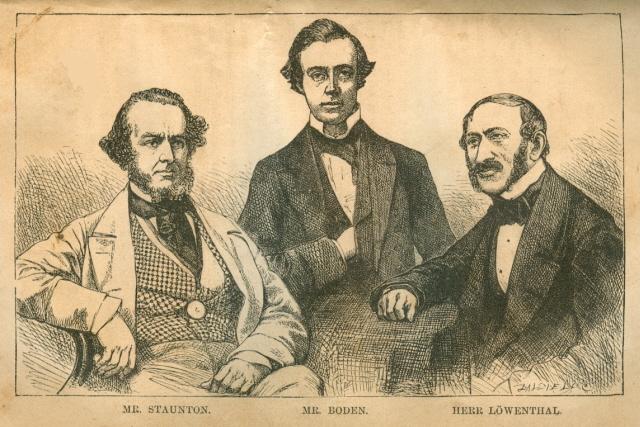
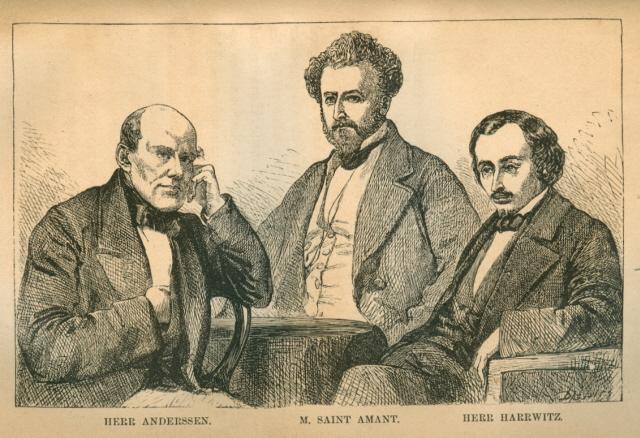
From opposite pages 96 and 150 of the 1859 US edition of F.M. Edge’s book on Morphy.
Page 79 of David Lawson’s 1976 monograph on Morphy had an illustration captioned ‘Morphy’s American opponents’. They were not identified, and we therefore give the version published on page 54 of the May-June 1950 American Chess Bulletin:
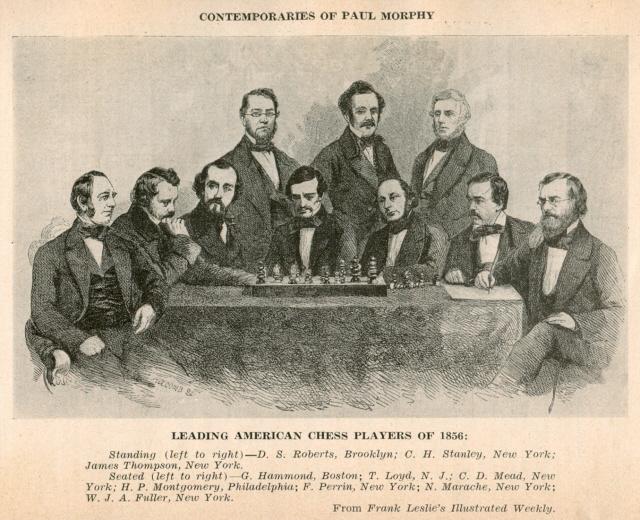
‘Pillsbury was the first master to realize that combinations directed at the opponent’s king were affected by conditions outside of that immediate area. Control of the center was an important factor, while possession of the square B5 on the queen side (remarkable concept!) could be decisive in effecting mate on the king side. Pillsbury’s combinations were often large-scale productions, involving operations on the whole board.’
Source: Combinations The Heart of Chess by I. Chernev (New York, 1960), page 124.

This set of photographs has now assumed its proper place in a feature article.
1 e4 e5 2 d4 exd4 3 Bc4 Nc6 4 Nf3 Nf6 5 O-O Be7 6 Nxd4 O-O 7 Nc3 Bc5 8 Be3 Ne5 9 Bb3 Nfg4 10 Bf4 d6 11 h3 Nf6 12 Be3 c6 13 f4 Ng6 14 Qd3 a5 15 a4 Nh5 16 Nce2 Qe8 17 g4 Nf6 18 Ng3 b6 19 g5 Nd7 20 Nxc6 Ba6 21 c4
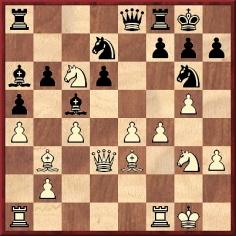
21...d5 (‘Ce coup extraordinaire décide la partie.’) 22 Nd4 dxc4 23 Bxc4 Nde5 24 fxe5 Nxe5 25 Bb5 Nxd3 26 Bxe8 Rfxe8 27 Rf3 Ne5 28 Rf4 Rad8 29 Ndf5 Nd3 30 Bxc5 Nxf4 31 Bxb6 Rd2 32 Bxa5 Nxh3+ 33 Kh1 Rxb2 34 Nxg7 Rc8 35 N7h5 Rcc2 36 Nf6+ Kf8 37 Ng4 Nxg5 38 Rd1
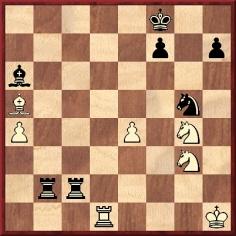
38...Bd3 and White resigned after two or three further moves.
Source: Le Palamède, January 1847, pages 34-35.
From Avital Pilpel (Haifa, Israel):
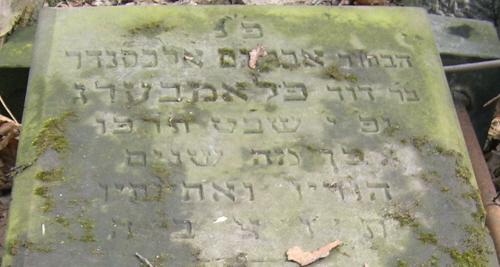
‘Flamberg, like many European Jews, had two forenames – one “Jewish” (Avrohom) and one “Gentile” (Aleksander). The point of such double names (usually beginning with the same letter) was to make assimilation easier. One would use the Jewish name within the Jewish community, especially for religious purposes, and the Gentile one within the larger, Gentile world.
The Hebrew on the gravestone says:
“Here is buried
The bachelor Avrohom Alexander
Son of David Flamberg
Died on the tenth of the month of Shvat 5686
Aged 45 years
[mourned by] His parents and sisters.”Avrohom, Avraham, Abraham, etc. are all variant spellings (or pronunciations) of the same Hebrew name אברהם – i.e. the name of the biblical patriarch.’
This photograph of Olga and Vera Menchik in Hastings was published on page 3 of the January 1930 American Chess Bulletin:
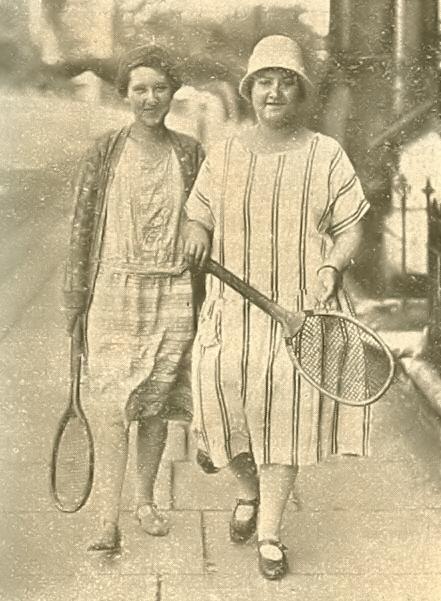
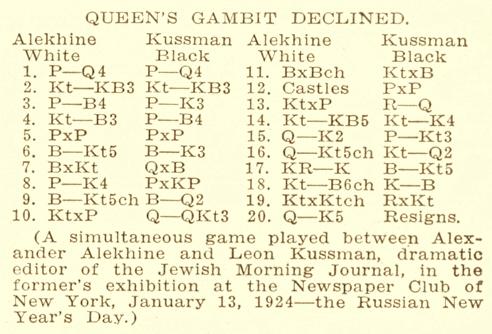
American Chess Bulletin, January 1924, page 8
Russell Miller (Camas, WA, USA) informs us that the ancestry.com webpage offers basic information about Leon Kussman, such as his dates: 1884-1977.
Our collection includes an inscribed copy of Kussman’s poems in Yiddish, Mein Stam (New York, 1940):
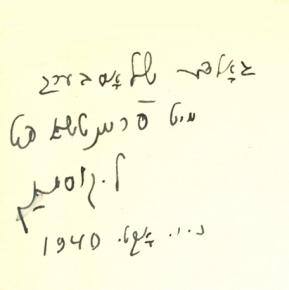
One of T.H. Tylor’s very rare forays into chess writing was ‘The Grand Masters’ on pages 26-29 of the anthology Home and Away (London, 1948). Directed at a mainstream audience, the article contained little that is quotable, although on page 28 he described Alekhine as ‘perhaps the greatest chess genius of them all’.
Some years ago (see pages 230-232 of Kings, Commoners and Knaves) we discussed chess connections involving Viveca Lindfors and Errol Flynn, who co-starred in the 1948 film Adventures of Don Juan. In passing we described Viveca Lindfors as ‘the only screen goddess lucky enough to marry a FIDE President’ (i.e. Folke Rogard). This 1946 photograph of the couple appeared in her autobiography Viveka ... Viveca (New York, 1981):
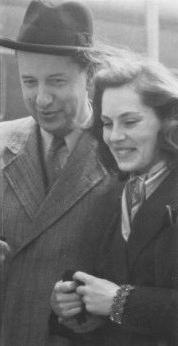
She was later married to the actor and writer George Tabori, and her book also has the following shot, ‘the first picture of the Tabori-Lindfors family in the house on 95th Street’:
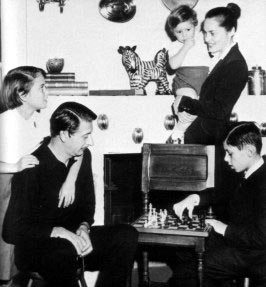
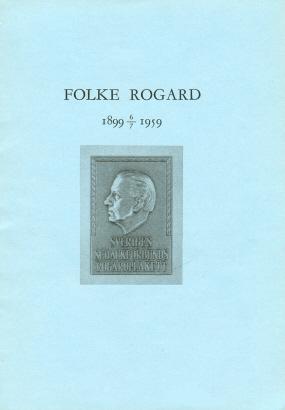
Calle Erlandsson (Lund, Sweden) has sent us a 20-page booklet, Till Folke Rogard på 60-Årsdagen (Örebro, 1959), which marked the then FIDE President’s 60th birthday. Pages 14-15 gave this game:
Folke Rogard – L. Bohmgren1 e4 Nf6 2 e5 Nd5 3 d4 d6 4 Nf3 c5 5 c4 Nb4 6 a3 Qa5 7 Bd2 Bf5 8 Nh4 Bg6 9 Nxg6 hxg6 10 exd6 exd6 11 Nc3 N4c6 12 d5 Nd4 13 Nb5 Qb6 14 Nxd4 cxd4 15 Bd3 Be7 16 O-O Nd7 17 b4 Kf8 18 f4 Bf6 19 Kh1 Re8 20 g4 a5 21 g5 Bd8 22 Qg4 Qc7 23 Rae1 Rxe1 24 Rxe1 Nb6 25 Qe2 Be7 26 Qe4 Qd7 27 Bf1 Nc8 28 Qxd4 Qg4 29 Qe3 f6
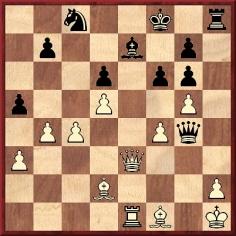
30 c5 Qd7 31 Bg2 axb4 32 c6 bxc6 33 dxc6 Qc7 34 axb4 and White won.
The booklet’s illustrations included, on page 6, a shot of Rogard playing lightning chess against Smyslov:
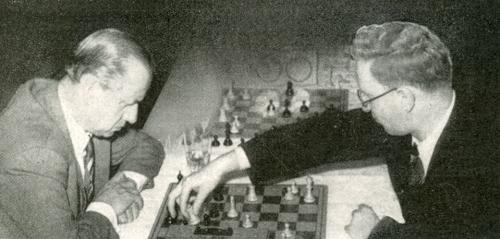
In C.N. 5788 a correspondent asked for information about the British Chess Company, and we now reproduce a feature entitled ‘A Chess Industry’ from page 65 of the 17 April 1895 Chess Player’s Chronicle. It quoted a correspondent who had written to the Cheltenham Examiner:
‘A factory principally devoted to the turning out of thousands of chessmen annually is a striking testimony to the growing popularity of the royal game of chess, and a brief notice of a visit to the Rock Mill factory of the British Chess Company, at Stroud, may be not unwelcome. The building is situated on the Painswick-road, about a mile from Stroud, and the motive power is amply supplied by a rapid brook, which here forms a pretty cascade of about 12 feet in depth, the water foaming and frothing over rugged and projecting rock. The substantial building is of three floors, and was formerly an ironwork factory. On the ground floor is a stock of seasoned woods – ebony, rosewood and boxwood – which are sawn or sliced into thin veneers for the chess squares, while cubes suitable for chessmen are cut into various sizes, and also flat slabs for chess boxes and the backs of boards. On the higher floor, the turner and joiner are busily at work turning the chessmen and plugging the stems with lead for the club sets; handsome boxes are being morticed, and the ivory and rosewood mosaics neatly adjusted. A still higher floor has the French polisher, and women finishing off the linings and silver plates of the boxes of prize sets. The Company possess a patented pattern of very ornate chessmen, but their modification of the old Staunton pattern, approved by Mr Blackburne, is most popular at matches, and the materials for the late British and American match were of this pattern and supplied from their stock. A very ingenious set of men was prepared especially for the Chess Lectures of Mr Lasker, which required vertical diagrams of chess openings. This problem was solved by cutting out flat pieces of large dimensions which were hooked on to the desired squares, the chessmen resembling somewhat those pieces of puzzle maps which were in vogue 20 years ago. Of course, the colours selected were only determined upon after experiments made under gas and electric light. On leaving, our reflection was, would that Gloucestershire turned out as many chessplayers as its factory does chessmen.’
The following game, ‘played recently at Simpson’s Divan’ was published on pages 353-354 of the July 1891 BCM:
Oscar Conrad Müller – William Grundy1 e4 e5 2 Nf3 Nc6 3 d4 exd4 4 Nxd4 Bc5 5 Be3 Qf6 6 c3 Nge7 7 Qd2 O-O 8 Be2 Nxd4 9 Bxd4 Bxd4 10 cxd4 d5 11 e5 Qg6 12 O-O Bh3 13 Bf3 f6 14 exf6 Rxf6 15 Qe3 Raf8 16 Bxd5+ Nxd5 17 Qxh3 Rf3 18 Qd7
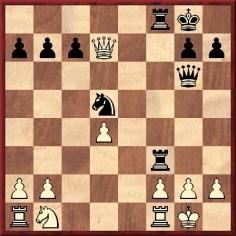
18...Ne3 and wins.
S. Tinsley’s concluding note was:
‘This is gem, well worthy of presentation. Mr Grundy deserves a hearty word of thanks for a game of the first order.’
The score was also given on pages 207-208 of the Chess Player’s Chronicle, 17 July 1895 under the heading ‘A masterpiece by the late headmaster of Malvern Grammar School’. A note at the end read:
‘A very charming and clever series of moves, showing Mr Grundy’s natural genius for the game.’
The way three black pieces arrive on the third rank is certainly attractive, but such a game would hardly be praised so highly nowadays.
O.C. Müller published his memoirs in the BCM in 1932 (October, pages 438-439; November, pages 481-486; December, pages 533-535). Some quotes:
C.N. 3212 (see pages 199-200 of Chess Facts and Fables) cited some views on H.J.R. Murray’s book A History of Chess (Oxford, 1913). The following improbable addition comes from page 286 of CHESS, 29 June 1963:
‘It was said of Murray’s History that it grips like a novel.’
CHESS, 15 July 1964, pages 338-339, reproduced two photographs (dated, it was suggested, circa 1890) submitted by Miss E.G. Bell of Worthing:
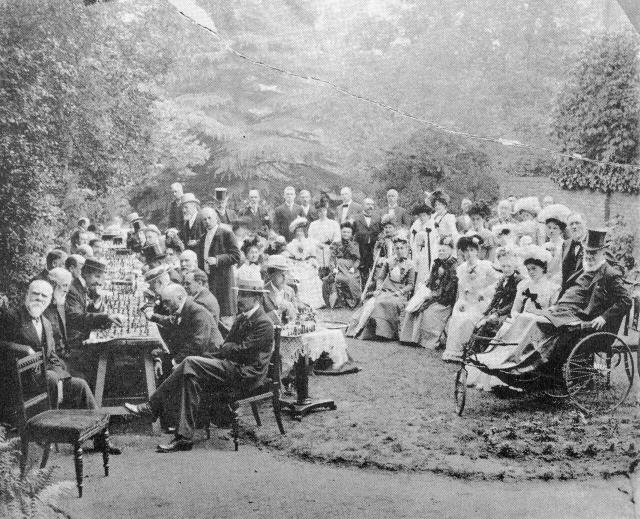
She believed that the above photograph was taken in the garden of a chess club in Nightingale Lane, Balham, the man in the Bath-chair being identified as H.E. Bird.
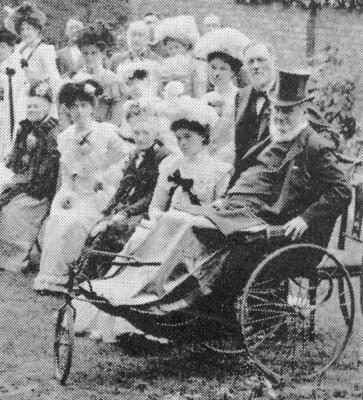
CHESS stated that the other photograph (below) ‘was
taken at a presentation to Mr W.T. Marshall, Hon. Sec. of the
Nightingale Club, a cousin of Miss Bell, who still holds the set
and board which were the subject of the presentation. Swinford
Ward is in this picture.’ (We take that to be a reference to H.
Swinburn Ward, whose photograph appeared on page 56 of the
February 1901 BCM.)
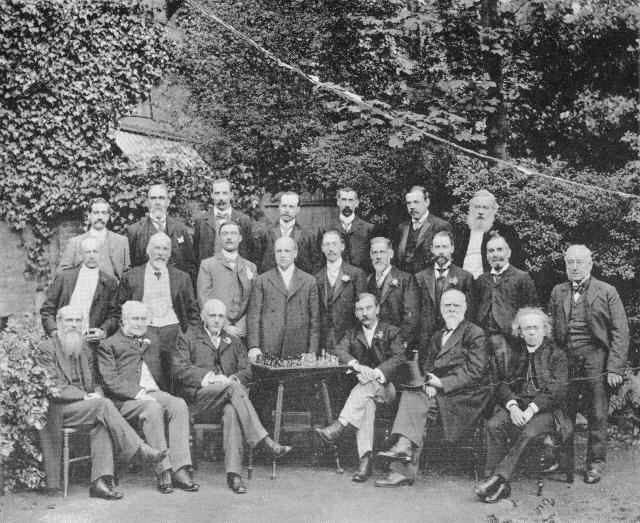
On page 360 of the 20 August 1964 CHESS a reader, Alfred Milner, suggested that in the first photograph J.H. Blackburne was ‘the gentleman in a white trilby watching the games’, and he noted that the man on the extreme left in the first photograph seems to be seated second from the right in the other shot.
Assistance with identifying any figures will be appreciated. The CHESS item was apparently wrong regarding the estimated date, for we note the following on page 251 of the June 1908 BCM, in Bird’s obituary:
‘The last public appearance of Mr Bird was on 22 June 1901, when he was present, in a Bath-chair, at a garden party given by Doctor and Mrs Dunstan to the members of the Nightingale Lane Chess Club on the occasion of the presentation of a testimonial to Mr W.T. Marshall, the club’s secretary.’
Tom Brown (Baltimore, MD, USA) asks about the origins of the chess terms ‘rank’ and ‘file’ and how their dating compares with that of the military phrase ‘rank and file’.
The Oxford English Dictionary has the following entries:
‘1598 R. Barret Theorike & Pract. Mod. Warres III. 34: “To learne to keepe his ranke and file orderly.”
1597 G. B. Damiano da Odemira’s Ludus Scacchiæ: Chesse-play sig. Diijv: “Moouing a Pawne from left hand side, which on the fourth ranke stood.”
1614 A. Saul Chesse-play i. 3: “Imagine that the blacke King for his first draught playeth his owne Pawne into the third house in his owne file.”’
Further to C.N. 5777, regarding the ‘balcony shots’ of the Latvian, United States and British teams at the 1933 Olympiad in Folkestone, we add a photograph of the Hungarian team, from volume four of Magyar Sakktörténet (Budapest, 1996):
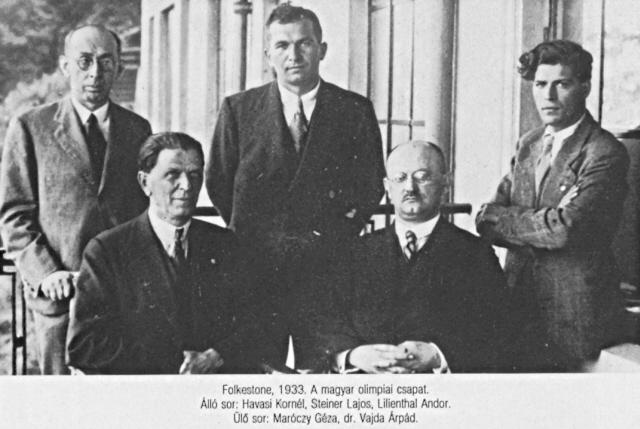
A report which is slightly older than the one quoted in C.N. 3735:
‘The Pope is a remarkably good chessplayer, says “Pearson’s”. In fact, it is only on rare occasions that he is defeated at the game. There is one priest in Rome who is usually the Pope’s adversary. This priest – Father Giella [sic] – has played chess with his Holiness for 32 years past. When Cardinal Pecci was raised to the Papal throne Father Guilla [sic], who was then residing in Florence, received an invitation to proceed to Rome and take up his quarters in the Vatican. He is a magnificent player, but so hot-tempered that the Pope often improves the occasion by a little homily on the virtues of resignation and meekness.’
Source: Chess Player’s Chronicle, 21 August 1895, page 243.
Michael Clapham (Ipswich, England) notes that page 166 of The Chess-Player’s Annual for 1856 edited by Charles Tomlinson (London, 1856) mentioned photographs taken by Rosario Aspa at the Leamington chess meeting held the previous year:
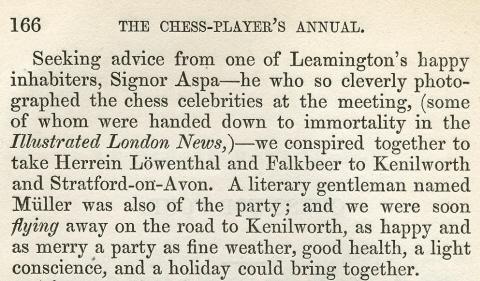
Our correspondent provides from his collection this tinted version of the well-known group picture from the Leamington meeting:
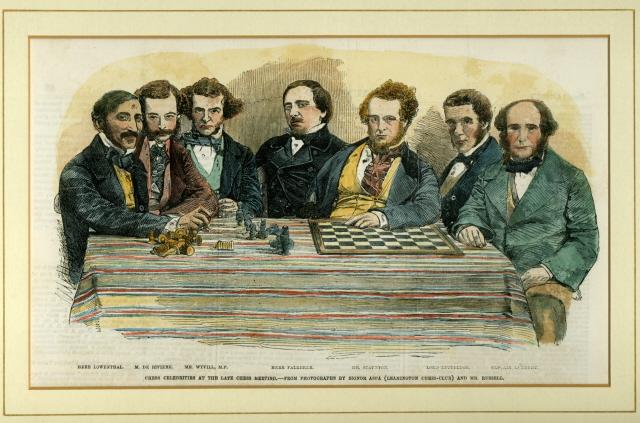
Mr Clapham also raises the subject of the oldest chess photograph of any kind (i.e. depicting non-masters), and he mentions an illustration on page 163 of Chess A celebration of 2000 years by R. Finkenzeller, W. Ziehr and E. Bührer (London, 1990):
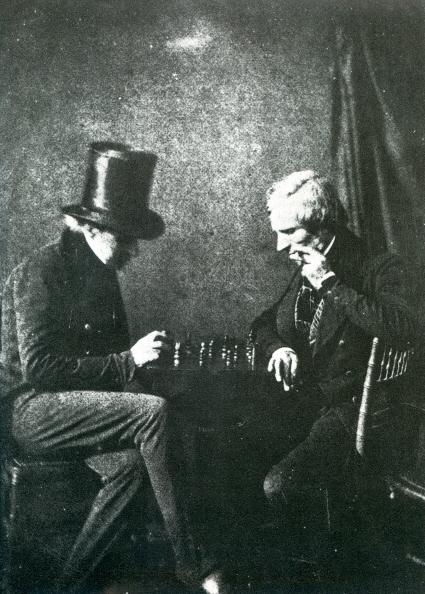
The caption on the previous page stated:
‘In 1840, Fox Talbot photographed two chessplayers and left to posterity one of the first daguerreotypes produced in England. Talbot was one of the pioneers of photographic art and here he has brilliantly captured the tension that prevails during a chess game.’
Page 207 credited the photograph to the ‘Archive Motovun Verlagsgesellschaft, Lucerne’.
We note, though, that a photograph ostensibly taken on the same occasion was dated 1846 on page 8 of Chess The Records by K. Whyld (Enfield, 1986):
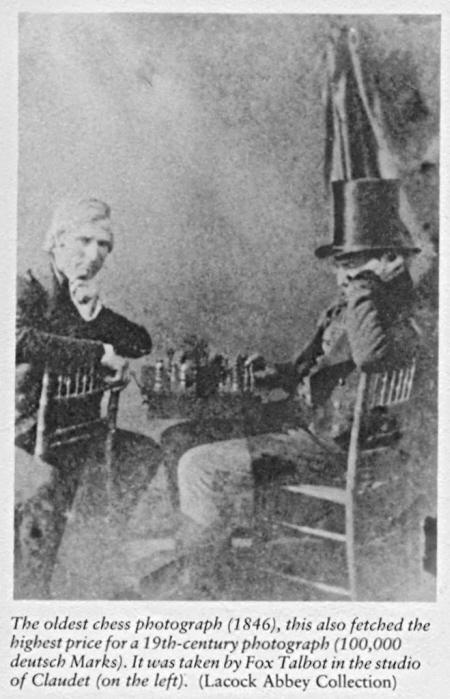
Antoine Claudet (1797-1867) was a French photographer.
From Mark N. Taylor (Mt Berry, GA, USA):
‘On page 287 of Means Davis’s novel The Chess Murders (New York, 1937) a character remarked regarding H.J.R. Murray’s work: “I wouldn’t take that book too seriously”.
Davis also introduced two chessic phrases which never caught on: “playing chess on it” (page 263), i.e. thinking about a problem as a chessplayer thinks about a position, and “it wouldn’t be chess” (pages 300-301), i.e. it would not be fair or admit a logical response.’
Tim Harding (Dublin) writes:
‘Regarding your query in C.N. 5958 about what became of Aspa’s archives, his scrapbooks are in the John G. White Collection in Cleveland under the following references:
“ASPA, ROSARIO
Chess articles, games, problems and game endings by Rosario Aspa; collected from his papers and arranged by John G. White. 789.32M AS61C2
Chess miscellanies: games, problems and game endings. Q 789.31 O1A V.1 AND V2.”’
Kevin Marchese (Canal Winchester, OH, USA) asks whether more is
known about the projected Europe v America chess match mentioned
in the New York Times and the Washington Post of
21 May 1904 (pages 9 and 8 respectively). The full item in the Washington
Post was:
‘Cambridge Springs, Pa., 20 May. – At an informal dinner attended by the competitors in the international chess masters’ tournament, which closed yesterday, it was decided to hold a team match, Europe v America. The match will be played in New York Friday and Saturday next, and each team will be composed of six men. The Brooklyn and Manhattan chess clubs have been approached with a view to holding the contest at their rooms.’
Ernest Tomlinson (Seattle, WA, USA) wishes to know the source of a quote commonly attributed to Mikhail Tal. Concerning a campaign in the Soviet Union against alcoholism, he supposedly commented that if the State was against vodka, he was on the side of vodka.
Below is an inscription by Tal (Black against Fischer) on page 153 of our copy of Kandidatenturnier für Schachweltmeisterschaft by S. Gligorić and V. Ragozin (‘W. Ragosin’), published in Belgrade in 1960:
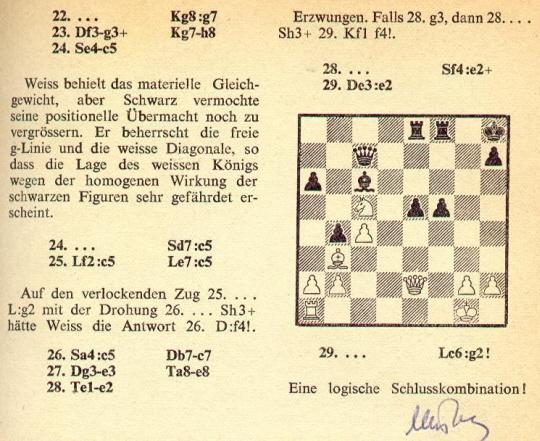
| First column | << previous | Archives [54] | next >> | Current column |
Copyright: Edward Winter. All rights reserved.